
Formerly known as European gypsy moth

The spongy moth (Lymantria Dispar) is an invasive moth that arrived from Europe in the 1800s and was first found in Wisconsin in the 1960s. Because they are non-native to the United States, we have few natural enemies to control them. Infestations can significantly defoliate over 500 species of trees and shrubs, making them a threat to our urban trees and forests. Early detection is critical to limiting their spread.
Wisconsin is currently experiencing a spongy moth outbreak. 
The Department of Agriculture, Trade, and Consumer Protection has reported an 102% increase in male spongy moths caught in trapping surveys last year in Wisconsin. Likewise, the Wisconsin Department of Natural Resources reported over 85,000 acres defoliated in Wisconsin in 2022, up from 294 in 2021.
Spongy moth populations typically have a temporary, large increase in population every 10-15 years, which lasts 2-3 years. Right now we are in the midst of one of these outbreaks, which is made worse because it is happening during a Extreme/Severe drought in Dane County. As a result of the drought, our trees are less resilient than in a typical year, which means they are more vulnerable to additional stressors like spongy moths.
Although mature trees generally rebound with new leaves to replace the ones that have been lost, this takes additional energy at a time when trees are already stressed due to drought. Being proactive about tree maintenance can help mitigate the risk of loss to affected trees.
Read more about the current spongy moth outbreak here and here.
Signs of a infested trees vary depending on the time of year. Use the table below to determine if a tree is infested. Learn more about their life cycle and see additional pictures here.

Egg masses are visible on the tree and surrounding area, which can be any type of surface like cars, household furniture, etc.
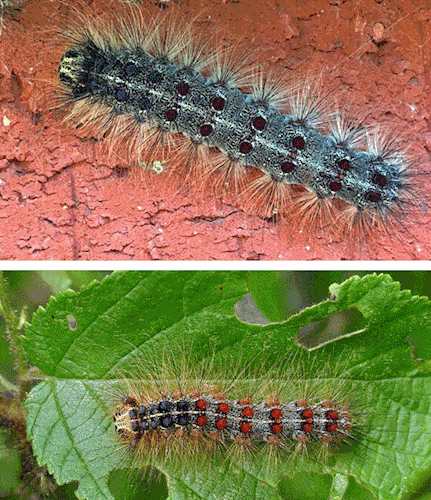
Caterpillars begin to emerge and can be observed on the tree bark and leaves.

Moths begin to emerge. Females are white and do not fly. Males are brownish.
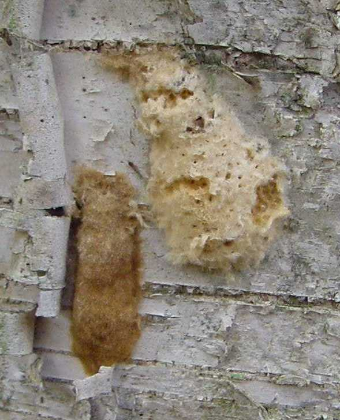
Egg masses can be observed on the bark, branches, nearby buildings, etc. New egg masses are firm and old ones are pale and crush easily.
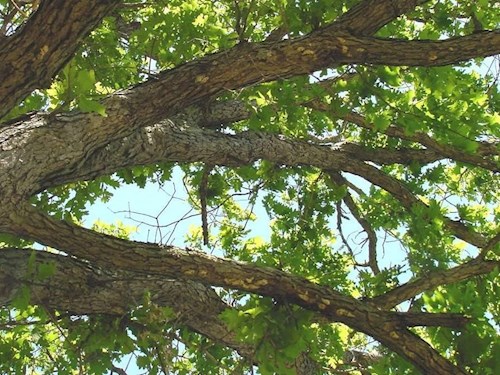
If a tree is infested and experiences less than 50% defoliation, the tree will generally survive with no significant impacts. If deciduous trees are more than about 50% defoliated they will still generally refoliate as long as defoliation occurs before mid-summer. However, they do expend carbon resources to refoliate, so this does weaken the tree. Weak trees that are already stressed by other factors (drought, disease, insect infestation and soil compaction) may die after one year of heavy defoliation. Healthy trees may die after two or more years of heavy defoliation. However, this would be unusual; most trees can tolerate several years of defoliation if they are healthy. It will weaken them but not often kill them outright after two years. However, stressed and weakened trees are more susceptible to secondary insect/disease issues, which could ultimately cause dieback and death over time.
The first action that a homeowner should take is to assess as completely as possible the extent of an infestation. This includes looking for both signs of defoliation and egg masses on already impacted trees and other trees in the near vicinity. If you believe that the spongy moth is present in your yard, then it is highly recommended that an ISA-Certified Arborist be contacted to further analyze tree health factors, assess the conditions of the infestation, and discuss possible responses.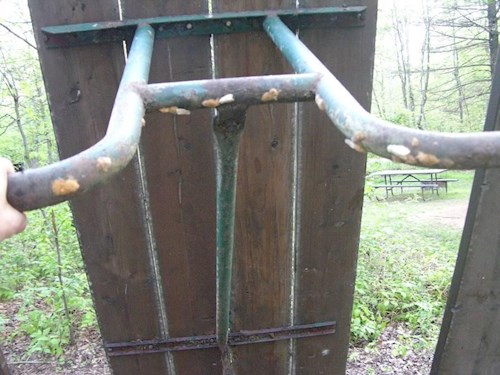
If your tree is infested, see UW-Extension resources for guidance on how to respond, which varies depending on the time of year. Manual egg mass removal, barrier bands, caterpillar collection under burlap and insecticides are all options but must be applied correctly and within the right window of time for them to be effective. The Wisconsin Department of Natural Resources also maintains a spongy moth portal for additional guidance on how to respond and manage your property.
Also consider that an infestation in one yard can have significant impacts across a neighborhood. An organized neighborhood monitoring program can track the direction and populations of the spongy moth. See below for a reporting tool that can be used to help track infestations in your area.
And keep in mind that caterpillar hairs may cause an allergic reaction so do not touch caterpillars, pupae or egg masses with bare hands.
Reduce Tree Stress
In all scenarios, the most important action you can take as a homeowner is to ensure your trees can endure the damage caused by spongy moth caterpillars by reducing other stressors.
First, even mature trees benefit greatly from regular watering, especially during a drought. Established trees should receive a minimum of five gallons of water per inch of trunk diameter. Measure your tree’s diameter at 4.5 feet up from the base of the tree. Ideally, the water should be evenly dispersed in the area under the tree’s drip zone from the edge of the canopy back to the trunk
Second, mulch your tree with a ring that is a minimum of 6 ft diameter and 3 inches deep and should not touch the trunk. Mulching is most effective when soil is moistened first before it is applied in order to retain ideal moisture. This will decrease competition from grass, conserve moisture, and cool the soil. In addition, avoid pruning and soil compaction around the tree. Although these actions will not prevent an infestation, they make the tree more resilient and likely to withstand the defoliation stress from spongy moth caterpillars.
Learn more about the current spongy moth outbreak and what you can do to mitigate risk on your own property from PJ Leish, Wisconsin Department of Natural Resources. The focus is awareness of spongy moth, how to identify it and monitor your yard and methods you can use to treat it if you find it.

Use this tool to report instances of observed spongy moth in the field (mobile version). Reporting instances of spongy moth can help neighborhoods track outbreaks as well as inform county, city, village, and muncipalities about known hot spots and understand where best to target prevention and treatment efforts.

Use this tool to report instances of observed spongy moth (desktop version).
Spongy moth management generally includes slowing the spread and suppressing active infestations through various control measures. Officials from across Dane County are collaborating on how to monitor, manage, and conduct public outreach around the current outbreak.
It is up to each local jurisdiction as to how they manage Spongy moth. For example, Dane County Parks are managed by Dane County Land and Water Resources, while cities manage their own parks. Management strategies vary greatly depending on budgets, staffing and knowledge. Some decide to let nature take its course – others decide that more active management and treatment are feasible.
Because resources for monitoring and spraying vary by jurisdiction, the responses to the 2023 outbreak differ. If you have questions about a particular park or public space, reach out to the local office that manages that space to learn more about their plans and what they are doing to manage the current outbreak.
Aerial Spraying in Dane County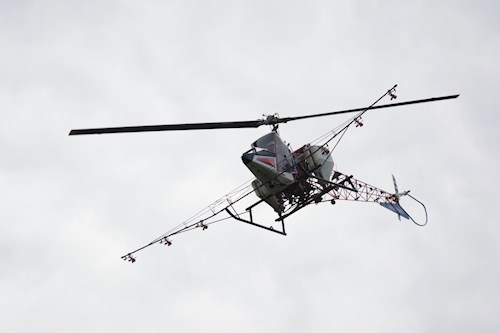
During the last time spongy moth threatened to defoliate stands of trees in Madison and other county communities in 2014, Dane County facilitated the participation in a state-organized suppression spray. Part of the reason this spraying program was possible was that the Wisconsin Department of Natural Resources rule governing the state suppression program included a legal process for landowners to object to treatment and have their property removed from the spray area. The rule specified that households needed to reach out to object to spraying or the state could assume approval of landowners for the treatment.
Although this suppression program did not eliminate the pest all together, it reduced the population and its effect on the trees. This state suppression program was discontinued and the rule governing it suspended in 2018 due to lack of participation and the cost for offering the program to the entire state.
Going forward, aerial spraying to reduce spongy moth populations in Dane County is possible. However, now that this program has concluded, municipalities interested in contracting aerial spraying require consent from all property owners within the area to be sprayed. Planes or helicopters applying pesticide can’t adjust the width of their plume and are moving very fast. This is why spray blocks have to be at least 10-20 acres, preferably rectangular, and not a checkerboard of sprayed and unsprayed properties. Targeting specific households that explicitly opt-in is not practical. In addition, spraying is at most a population reduction measure and necessitates months of planning and neighborhood contacts, requiring significant staff time and expense. And this spraying can only happen in the spring during a certain time of the spongy moth life cycle, and even then only when weather conditions are favorable.
How Can I Help?
Foremost, avoid being a vector for local infestations. Learn more about how to comply with local quarantine regulations to ensure moths are not transported to or from Dane County. Some areas also periodically ask for help monitoring the outbreak. Check with your local public agency to see if they are soliciting volunteer monitors.